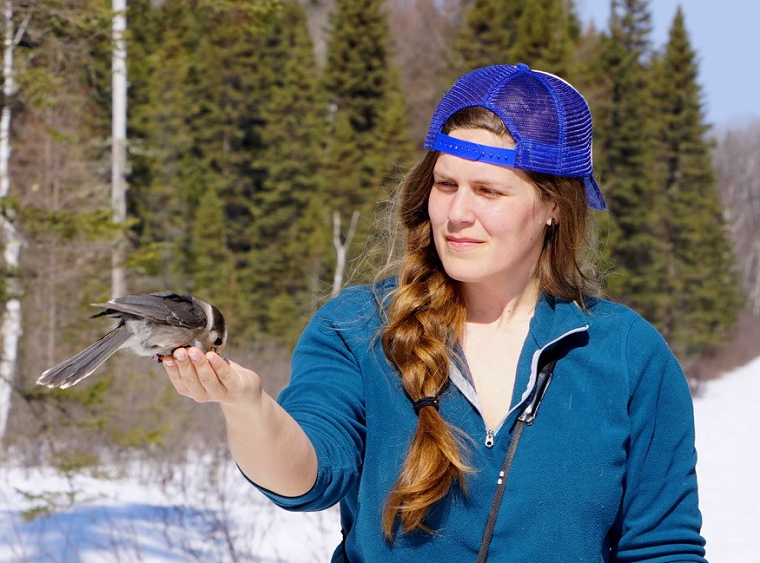Eat Lots, Fly Early: Supplemental Feeding Leads to Earlier Fledging in Canada Jays
By Bailey Bingham
28 February 2020

The Canada Jay is a well-loved feeder bird and will even boldly take handouts from the public. However, new research led by Profs. Amy Newman and Ryan Norris from the Department of Integrative Biology shows that the impact of these food handouts, especially during the breeding season, could be much more impactful on the jays’ life history than one might think.
In 2016, Canadian Geographic selected the Canada Jay as Canada’s national bird—and for good reason. These year-round residents of the boreal forest embrace the winter months, using the cold weather as their personal freezer to store their favourite perishable treats and beginning their breeding season in March, well before the last frost. Given this late-winter breeding season, Canada Jays rely primarily on stored food to feed their chicks, which means that food availability can be severely limited.
“We were really interested in how food quantity early in life could impact an individual, not only at their physiological level but also in terms of their life history,” says Koley Freeman, a PhD candidate with Newman and Norris, and lead author of the study.
Freeman and a team of researchers set out to answer this question with a field experiment in Algonquin Provincial Park.
“Our first step in the experiment was actually finding the nests,” says Freeman. Canada Jays have large territories and tend to nest high up in conifer trees—so this is no easy task. To solve this problem the researchers gave the jays nesting material and tried to follow them as they flew back to their nests. “We would just have to run as fast as we could through three feet of snow, in snowshoes, following a bird,” recalls Freeman, “and we did this for 35 nests.”
Once found, the nests were assigned to be either an experimental nest, where a bird feeder filled with high-quality food was placed nearby, or an un-supplemented control. Throughout the breeding season, the research team made daily snowshoe treks to collect body measurements and feather clippings (for nutrient analysis) from nestlings throughout Algonquin Park.
Analysis of these measurements clearly showed that the chicks from the supplemented nests had better nutrition and a higher body mass relative to their size, compared to their un-supplemented counterparts.
But the team’s most dramatic finding came from a serendipitous discovery that wasn’t even part of the original experimental design, recalls Freeman.
“I went to check on one of the first experimental nests—one that had been supplemented with additional food—and the nestlings weren’t there. I thought something had eaten them! But I happened to come back the next day and I found them hanging around near the nest. I realized that they hadn’t been eaten, they had just fledged early!”
Indeed, results showed that nestlings from supplemented territories fledged, on average, 5.5 days or 24% earlier than the nestlings from territories without extra food. This finding indicates that the Canada Jay’s ability to learn to fly is at least partly controlled by the quantity of food available to them.
Importantly, an earlier fledging date, combined with higher body mass, could also give these fledglings a huge competitive advantage.
“Fledging earlier could give these jays a real leg up on other members of their cohort in terms of finding a territory and finding a mate,” says Freeman. “This study really opens the door to looking at how supplemental feeding impacts the fitness of the next generation.”
Other major contributors to the study include Dan Strickland, Algonquin Provincial Park and Alex Sutton, Department of Integrative Biology.
Read the full article in the journal Ecology. (Javascript enabled browser required)
Read about other CBS Research Highlights.